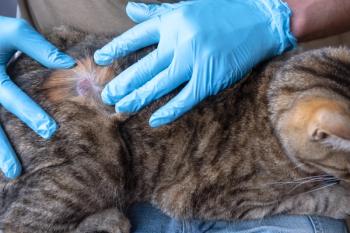
Betty White: The scourge of the veterinary profession?
Some veterinarians still link her to a 1-800 PetMeds endorsement and the Internet pharmacy boom. Are pet owners trusting their veterinarians less, and is White to blame?
2010 was a good year for Betty White. She took a hit in a football-themed Snickers commercial that aired during the Super Bowl, which prompted a new generation of fans to launch a successful Facebook campaign to have White host an episode of Saturday Night Live. Then the sitcom and movie appearances started rolling in, and today she’s a household name synonymous with the word “comeback.”
But for all of her recent publicity and success, DVM Newsmagazine’s 2012 State of the Profession Survey shows that some veterinarians still remember White for another role: the part she played in a 2007 PetMed Express commercial, with her infamous line, “I saved a trip to the vet!” And specifically, some veterinarians, concerned about what they perceive as their declining reputation among pet owners, point to White and PetMed Express as the cause.
For example, when asked to name the most pressing issue facing veterinarians, one survey respondent wrote, “[It’s the] do-it-yourself approach by an increasing number of pet owners—the false impression that we are out to rip them off. Thanks to popular advertising such as Betty White for PetMeds, clients no longer value our services.” And this respondent isn’t alone. Blog posts on the
When approached about White’s role in the 1-800 PetMeds commercials, spokesperson Rick Herch said this: “Betty did a commercial for PetMeds years ago, which we terminated as soon as we found out how vets felt about PetMeds. Again this ended a number of years ago, and the commercial only ran for a short period of time. I might add that we vetted this with some vets who had no problem with them, but obviously some others felt that they compete and undercut prices for some vets, which is the reason we terminated the agreement. Betty loves veterinaries (sic) and would never knowingly do anything that would be perceived as something contrary.”
Black and white
So what happens when two trusted sources go toe to toe? While veterinarians have long enjoyed an elevated relationship with the public, even as a group it’s hard to stand up to White’s longstanding role as a public figure and opinion leader (see Table 1, right). White, a lifetime achievement award winner from the Morris Animal Foundation, is clearly no lightweight in show business or in her role of championing of animal welfare.
Gallup stopped including veterinarians in its “honesty and ethics” survey after 2006, when they ranked as the third most-trusted profession. (While Gallup hasn’t included veterinarians in the survey since then, the profession will be included again in the 2012 survey, which Gallup plans to release later this year.) But a recent pet owner survey conducted by Advanstar Veterinary in 2012 shows that pet owners still rate veterinarians highly among other healthcare professionals (see “
To say that White also enjoys a strong reputation is an understatement. The 90-year-old, whose career spans seven decades, ranked as America’s favorite and most trusted personality as well as the one mostly likely to drive a brand purchase, according to a 2011 Ipsos survey of more than 2,000 adults in the United States. She enjoys an 86 percent favorable opinion rating and only a 3 percent unfavorable one, edging out Denzel Washington, Sandra Bullock and Clint Eastwood. She also ranks in the top 10 celebrities who can offer the most pull with brand endorsements. So it’s easy to see why veterinarians have worried about her now defunct endorsement. It’s clear that White’s commercial support carries weight with consumers.
This doesn’t, however, make her an enemy of veterinary medicine. Steve Dale, a contributing editor at USA Weekend and host of two nationally syndicated radio shows, Steve Dale’s Pet World and The Pet Minute, and Steve Dale’s Pet World at WLS Radio, Chicago, has interviewed Betty White several times. He says White is a strong advocate not only for pets and wildlife, but also for the veterinary profession.
“I don’t believe that there is a celebrity on the planet who has done more to promote the plight of companion animals and wildlife than Betty White,” Dale says.
White’s connection with people is one veterinarians should understand. While many fans recognize her as a celebrity, they also view her as a pet lover and animal advocate. “I’ve been at events with her. People go up to her and they don’t say, ‘Hello, Ms. White,’ they say, ‘Hello, Betty.’ She’s like a dear aunt,” Dale says. “Secondly they don’t ask for her autograph. They pull out their phones and they show her pictures of their pets. America knows Betty White loves animals.”
Ironically, Dale says it’s White’s beloved persona that may contribute to the lingering animus some veterinarians feel. “Do you remember who did the Crest toothpaste commercials three months ago?” he says. “Of course not, but we remember the PetMeds commercials, and it’s because it was Betty White doing them.”
Getting past 1-800 PetMeds
Founded in 1996, PetMed Express began gaining ground in the late ’90s and early 2000s. By 2006, PetMeds ranked fourth in Forbes magazine’s 200 Best Small Business Companies and hit No. 27 in BusinessWeek’s list of top 100 Hot Growth Companies. White’s commercial endorsements began in January 2007 but were quickly pulled. And as flea and tick preventives become more readily available, some experts believe PetMed Express as a company and a business model is on the wane.
“I’m no fan of PetMed Express, but really they’ve become less relevant. You can buy flea and tick prevention almost anywhere, including the big box stores,” Dale says.
Whether it’s PetMeds, Walmart or other big box stores, Dale says the central problem is that pet owners believe they can get medications cheaper over the counter—an assumption that isn’t necessarily true. Another concern, he says, is what they’re actually buying for their pets. Without a veterinarian’s guidance, they may make purchasing decisions based on price, product availability or marketing.
“The veterinarian knows all the possible potential flea and tick products and what is going to be appropriate for the right household,” Dale says. “The consumer can’t possibly know all of these things.”
Proper application is also a concern when pet owners purchase products from retailers, Dale says. “You can’t be in their homes, ringing the bell, walking into their house the 12th of every month saying, ‘It’s time!’,” he says. “But at least you can have a conversation about it. And the store is not going to do that.”
Another large concern, Dale says, is the number of pet owners skipping regular pet exams. What these pet owners don’t realize is that by missing these valuable exams, veterinarians don’t get the chance to diagnose conditions like cancer and renal disease earlier in the process.
“We’re seeing more of these diseases and even more flea infestations,” Dale says. “And it’s not a problem with the products. It’s a combination of people failing to choose the correct products and failing to apply them properly. And it’s more expensive on the other end to fight fleas and hire the exterminator than it is to pay for the right product in the first place.”
Mend your broken fences
In 2006, at the height of PetMed’s success, veterinarians still ranked No. 3 in the Gallup’s honesty and ethics survey. So if veterinarians have lost ground (which hasn’t been demonstrated by any data DVM Newsmagazine could find but which some people report anecdotally), it’s likely they can recover it. While Dale says the veterinary profession needs to catch up with other medical professions as far as pricing, he admits that they may have stumbled a bit on the approach.
“The example I often use is a letter I received from a pet owner in Boston,” Dale says. Her poodle had cancer, and the owner elected to do surgery. When she received the invoice, it listed every charge, from anesthesia to a nail clipping, which was $6.
“They were frustrated that they were paying $3,000 and the veterinarian charged $6 for the nail trim. So nickel-and-diming angers people—you lose their trust and you lose the client. And then they begin to think, ‘By gosh, even the veterinarian is doing it all for money.’”
While most veterinarians aren’t guilty of this, Dale says the Internet gives more power to these stories. People don’t stop on the street when they’re walking their dog and talk about their concerns. They take them to list-serves and websites.
Ernie Ward, DVM, owner of Seaside Animal Care in Calabash, N.C., says he’s been concerned about the reputation of veterinarians for a while, and he also points to improper pricing strategies as one reason. “This pricing pressure has led many people to a misperception that veterinarians are outrageously priced. So that has damaged our reputation,” he says.
Specifically, he says veterinarians initially charged more than online retailers, leading to the perception that they overcharged. “We did this ourselves. I think the light was shown on us and we were embarrassed,” he says. “By and large, most veterinarians now charge what online retailers and discount stores charge. I think where we’re failing is we don’t tell people that.”
Very few pet owners understand that their veterinarian is price-competitive, and many don’t realize that their veterinarian may have an online store, Ward says. When it comes to pricing issues, he says veterinarians always need to talk about value.
With the growing Internet-fueled, social media pressure of negative media stories, Ward says it’s important to come back with client education in the exam room—and in the media.
“I think too often we do simple things,” he says. “We give away a free nail trim or anal sac expression, when we really ought to be doing things like work with community shelters.”
His recommends reaching out in your community to demonstrate your compassionate care. For example, Dr. Ward’s practice recently assisted with a large puppy mill bust in his community. The result: They made local news, both in newspapers and on television. While they didn’t seek the publicity, their volunteer work did demonstrate their passion for animal welfare in their community. These positive stories demonstrate the caring nature of the profession and counter the negative media stories.
Next, he recommends taking a hard look at your pricing strategies to make sure you are competitive. “If you’re charging twice as much for a flea and tick product than a client can buy online, that’s going to translate into, ‘If he’s charging me that much for this preventive, I can’t imagine what he’s charging me for the skin problem or the ear infection,’” Ward says.
Even so, he cautions against making lower prices and discounts your focus. Instead, he recommends staying competitive and educating pet owners to demonstrate your value. “You’ve got to let pet owners know the service you’re offering. And the simplest way to do that is by providing a very thorough, articulate examination,” he says. “Too often we rush through the most important part—the exam—and we don’t really explain what we’re doing. And people walk out believing you charge $50 for a five-minute exam.”
Effective exams don’t require spending a lot more time. It’s about making pet owners feel like you spent a lot of time with them, Ward says.
“Good communicators can make an exam a rich experience,” he says. “It feels longer than it actually takes, because you talk about what’s inside the eyes and the ears, the back of the throat, the teeth. It’s an engaging experience with clients, versus, ‘OK, we’ll see you next year.’”
Finally, Dale says it’s important for the profession to stop finger-pointing and turn its attention to getting pets back to the veterinarian. “Our pets lose if they don’t see the veterinarian for regular exams as well as advice on preventive products. But Betty White has nothing to do with it,” he says. “I’m not a fan of the ads she did or of PetMed Express, but it’s five years later, and Betty White is 90 years old. There’s one thing about companion animals. They remember stuff, but they don’t hold grudges. Maybe we could learn a lesson from them.”
Newsletter
From exam room tips to practice management insights, get trusted veterinary news delivered straight to your inbox—subscribe to dvm360.




